Preparation and Characterization of Instant Casein Phosphopeptide by Supercritical Fluid Assisted Atomization
Abstract
1. Introduction
2. Materials and Methods
2.1. Materials
2.2. Preparation of Instant SAA-CPP
2.3. Preparation of Instant SAA-CPP
2.4. Rheometer
2.5. Determination of SC-CO2 Absorption Rate
2.6. Dissolution Rate Measurements
2.7. Determination of Calcium-Binding Capacity
2.8. Foaming Properties
2.9. Angle of Repose
2.10. Sorption Isotherms
2.11. Other CPP Characterizations
2.12. Statistical Analyses
3. Results and Discussion
3.1. Effects of SC-CO2 Processing Conditions on CPP Solution
3.1.1. Viscosity
3.1.2. Porous Structure
3.2. Effect of SAA Processing Conditions on CPP
3.2.1. SC-CO2 Absorption Rate
3.2.2. Dissolution Time of SAA-CPP Powders
3.3. Characterizations of the SAA-CPP Powder
3.3.1. Morphology Analysis
3.3.2. Particle Distribution
3.3.3. Specific Surface Area and Pore Structure
3.3.4. Calcium-Binding Capacity
3.3.5. Physicochemical Properties
3.4. Effect of Different Drying Methods on the CPP
4. Conclusions
Author Contributions
Funding
Institutional Review Board Statement
Informed Consent Statement
Data Availability Statement
Conflicts of Interest
References
- Fang, F.; Hao, X.; Wu, Y.; Ying, M.; He, P.; Corcoran, D.; Chen, Q. Selection of marker peptides from casein phosphopeptide and application for quantification in infant formula. Food Addit. Contam. 2018, 35, 2077–2087. [Google Scholar] [CrossRef]
- Kumar, V.; Itthagarun, A.; King, N. The effect of casein phosphopeptide-amorphous calcium phosphate on remineralization of artificial caries-like lesions: An in vitro study. Aust. Dent. J. 2010, 53, 34–40. [Google Scholar] [CrossRef]
- Bennett, T.; Desmond, A.; Harrington, M.; Mcdonagh, D.; Fitzgerald, R.; Flynn, A.; Cashman, K.D. The effect of high intakes of casein and casein phosphopeptide on calcium absorption in the rat. Br. J. Nutr. 2000, 83, 673–680. [Google Scholar] [CrossRef]
- Hartmann, R.; Meisel, H. Cytochemical assessment of phosphopeptides derived from casein as potential ingredients for functional food. Food Nahrung 2002, 46, 427. [Google Scholar] [CrossRef]
- Hata, I.; Higashiyama, S.; Otani, H. Identification of a phosphopeptide in bovine αs1-casein digest as a factor influencing proliferation and immunoglobulin production in lymphocyte cultures. J. Dairy Res. 1998, 64, 569–578. [Google Scholar] [CrossRef]
- Quarto, M.; Nitride, C.; Ferranti, P.; Mauriello, R.; Chianese, L. Peptidomic study on in vitro and in vivo phosphopeptide release during the chewing of gum fortified with a commercial casein hydrolysate. Int. Dairy J. 2018, 79, 78–84. [Google Scholar] [CrossRef]
- Gupta, N.; Mohan, M.C.; Nagpal, R.; Singh, O.S.; Dhingra, C. A Review of Casein Phosphopeptide-Amorphous Calcium Phosphate (CPP-ACP) and Enamel Remineralization. Compend. Contin. Educ. Dent. 2016, 37, 36–39. [Google Scholar] [PubMed]
- Rival, S.G.; Fornaroli, S.; Boeriu, C.G.; Wichers, H.J. Caseins and casein hydrolysates. 1. Lipoxygenase inhibitory properties. J. Agric. Food. Chem. 2001, 49, 287–294. [Google Scholar] [CrossRef] [PubMed]
- Meisel, H. Biochemical properties of regulatory peptides derived from mil proteins. Peptide Sci. 1997, 43, 119–128. [Google Scholar] [CrossRef]
- Rogers, T.L.; Nelsen, A.C.; Sarkari, M.; Young, T.J.; Johnston, K.P.; Williams, R.O. Enhanced aqueous dissolution of a poorly water soluble drug by novel particle engineering technology: Spray-freezing into liquid with atmospheric freeze-drying. Pharm. Res. 2003, 20, 485–493. [Google Scholar] [CrossRef] [PubMed]
- Zheng, S.; Hu, X.; Ibrahim, A.R.; Tang, D.; Tan, Y.; Li, J. Supercritical Fluid Drying: Classification and Applications. Recent Pat. Chem. Eng. 2010, 3, 230–244. [Google Scholar] [CrossRef]
- Hu, G.; Zhang, S.; Xie, B. Micronization and Dissolubility of Griseofulvin Using Rapid Expansion of Supercritical Solution with Cosolvent Process. Asian J. Chem. 2013, 25, 10157–10159. [Google Scholar] [CrossRef]
- Klettenhammer, S.; Ferrentino, G.; Morozova, K.; Scampicchio, M. Novel Technologies Based on Supercritical Fluids for the Encapsulation of Food Grade Bioactive Compounds. Foods 2020, 9, 1395. [Google Scholar] [CrossRef]
- Buratto, R.T.; Chinchilla, M.I.; Cocero, M.J.; Martín, Á. Formulation of açaí (E. oleracea Mart.) Pulp and seeds extracts by co-precipitation in Supercritical Antisolvent (SAS) technology. J. Supercrit. Fluids 2021, 169, 105090. [Google Scholar] [CrossRef]
- Du, Z.; Tang, C.; Guan, Y.X.; Yao, S.J.; Zhu, Z.Q. Bioactive insulin microparticles produced by supercritical fluid assisted atomization with an enhanced mixer. Int. J. Pharm. 2013, 454, 174–182. [Google Scholar] [CrossRef]
- Wang, Q.; Guan, Y.X.; Yao, S.J.; Zhu, Z.Q. Microparticle formation of sodium cellulose sulfate using supercritical fluid assisted atomization introduced by hydrodynamic cavitation mixer. Chem. Eng. J. 2010, 159, 220–229. [Google Scholar] [CrossRef]
- Reverchon, E. Supercritical-Assisted Atomization To Produce Micro- and/or Nanoparticles of Controlled Size and Distribution. Ind. Eng. Chem. Res. 2002, 41, 2405–2411. [Google Scholar] [CrossRef]
- Porta, G.D.; Vittori, C.D.; Reverchon, E. Supercritical assisted atomization: A novel technology for microparticles preparation of an asthma-controlling drug. AAPS PharmSciTech 2005, 6, E421–E428. [Google Scholar] [CrossRef]
- Tomic, N.; Djekic, I.; Hofland, G.; Smigic, N.; Udovicki, B.; Rajkovic, A. Comparison of Supercritical CO2-Drying, Freeze-Drying and Frying on Sensory Properties of Beetroot. Foods 2020, 9, 1201. [Google Scholar] [CrossRef]
- Reverchon, E.; Antonacci, A. Cyclodextrins micrometric powders obtained by supercritical fluid processing. Biotechnol. Bioeng. 2010, 94, 753–761. [Google Scholar] [CrossRef]
- Reverchon, E.; Antonacci, A. Chitosan Microparticles Production by Supercritical Fluid Processing. Ind. Eng. Chem. Res. 2006, 45, 5722–5728. [Google Scholar] [CrossRef]
- Wang, Q.; Guan, Y.X.; Yao, S.J.; Zhu, Z.Q. Controllable preparation and formation mechanism of BSA microparticles using supercritical assisted atomization with an enhanced mixer. J. Supercrit. Fluids 2011, 56, 97–104. [Google Scholar] [CrossRef]
- Sievers, R.E.; Huang, E.T.S.; Villa, J.A.; Engling, G.; Brauer, P.R. Micronization of water-soluble or alcohol-soluble pharmaceuticals and model compounds with a low-temperature Bubble Dryer. J. Supercrit. Fluids 2003, 26, 9–16. [Google Scholar] [CrossRef]
- Cai, M.Q.; Guan, Y.X.; Yao, S.J.; Zhu, Z.Q. Supercritical fluid assisted atomization introduced by hydrodynamic cavitation mixer (SAA-HCM) for micronization of levofloxacin hydrochloride. J. Supercrit. Fluids 2008, 43, 524–534. [Google Scholar] [CrossRef]
- Elgazar, A.A.; Badria, F.; Mazy, E. Development of Provesicular Nanodelivery System of Curcumin as a Safe and Effective Antiviral Agent: Statistical Optimization, In Vitro Characterization, and Antiviral Effectiveness. Molecules 2020, 25, 5668. [Google Scholar]
- Nakamura, K.; Hoshino, T.; Ariyama, H. Adsorption of Carbon Dioxide on Proteins in the Supercritical Region (Food & Nutrition). Agric. Biol. Chem. 1991, 55, 2341–2347. [Google Scholar] [CrossRef][Green Version]
- Du, Z.; Guan, Y.X.; Yao, S.J.; Zhu, Z.Q. Supercritical fluid assisted atomization introduced by an enhanced mixer for micronization of lysozyme: Particle morphology, size and protein stability—ScienceDirect. Int. J. Pharm. 2011, 421, 258–268. [Google Scholar] [CrossRef]
- Adami, R.; Osséo, L.; Reverchon, E. Micronization of lysozyme by supercritical assisted atomization. Biotechnol. Bioeng. 2010, 104, 1162–1170. [Google Scholar] [CrossRef]
- Hossain, N.; Sabzoi, N.; Griffin, G.; Selvakannan, P.; Mahlia, T. Synthesis and characterization of rice husk biochar via hydrothermal carbonization for wastewater treatment and biofuel production. Sci. Rep. 2020, 10, 1–15. [Google Scholar] [CrossRef] [PubMed]
- Zakaria, S.; Mazyed, E.A. Enhancement of Dissolution Characteristics of Clopidogrel Bisulphate by Proniosomes. Int. J. Appl. Pharm. 2019, 11, 77–85. [Google Scholar] [CrossRef]
- Mohammad, K.; Nida, A.; Vijay, S.; Kamla, P. Product Development Studies on Sonocrystallized Curcumin for the Treatment of Gastric Cancer. Pharmaceutics 2015, 7, 43–63. [Google Scholar]
- Sormoli, M.E.; Langrish, T.A.G. Moisture sorption isotherms and net isosteric heat of sorption for spray-dried pure orange juice powder. LWT Food Sci. Technol. 2015, 62, 875–882. [Google Scholar] [CrossRef]
- Muzaffar, K.; Kumar, P. Moisture sorption isotherms and storage study of spray dried tamarind pulp powder. Powder Technol. 2016, 291, 322–327. [Google Scholar] [CrossRef]
- Goula, A.M.; Karapantsios, T.D.; Achillas, D.S.; Adamopoulos, K.G. Water sorption isotherms and glass transition temperature of spray dried tomato pulp. J. Food Eng. 2008, 85, 73–83. [Google Scholar] [CrossRef]
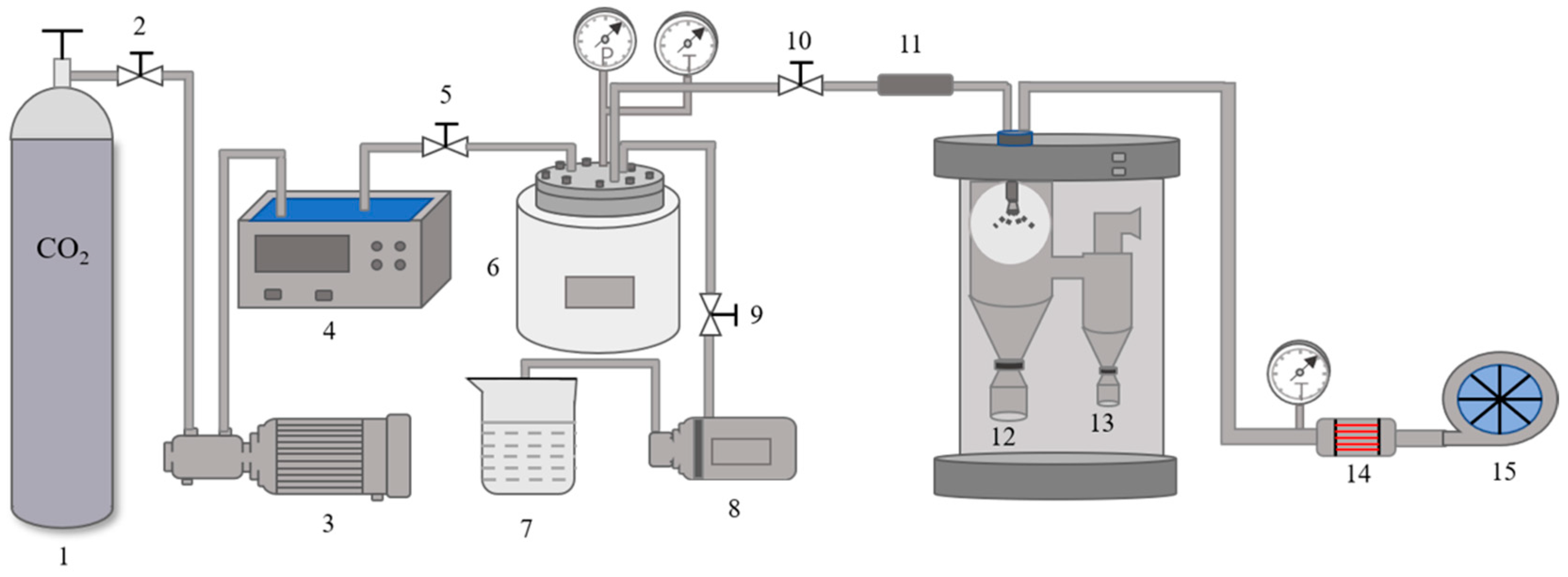

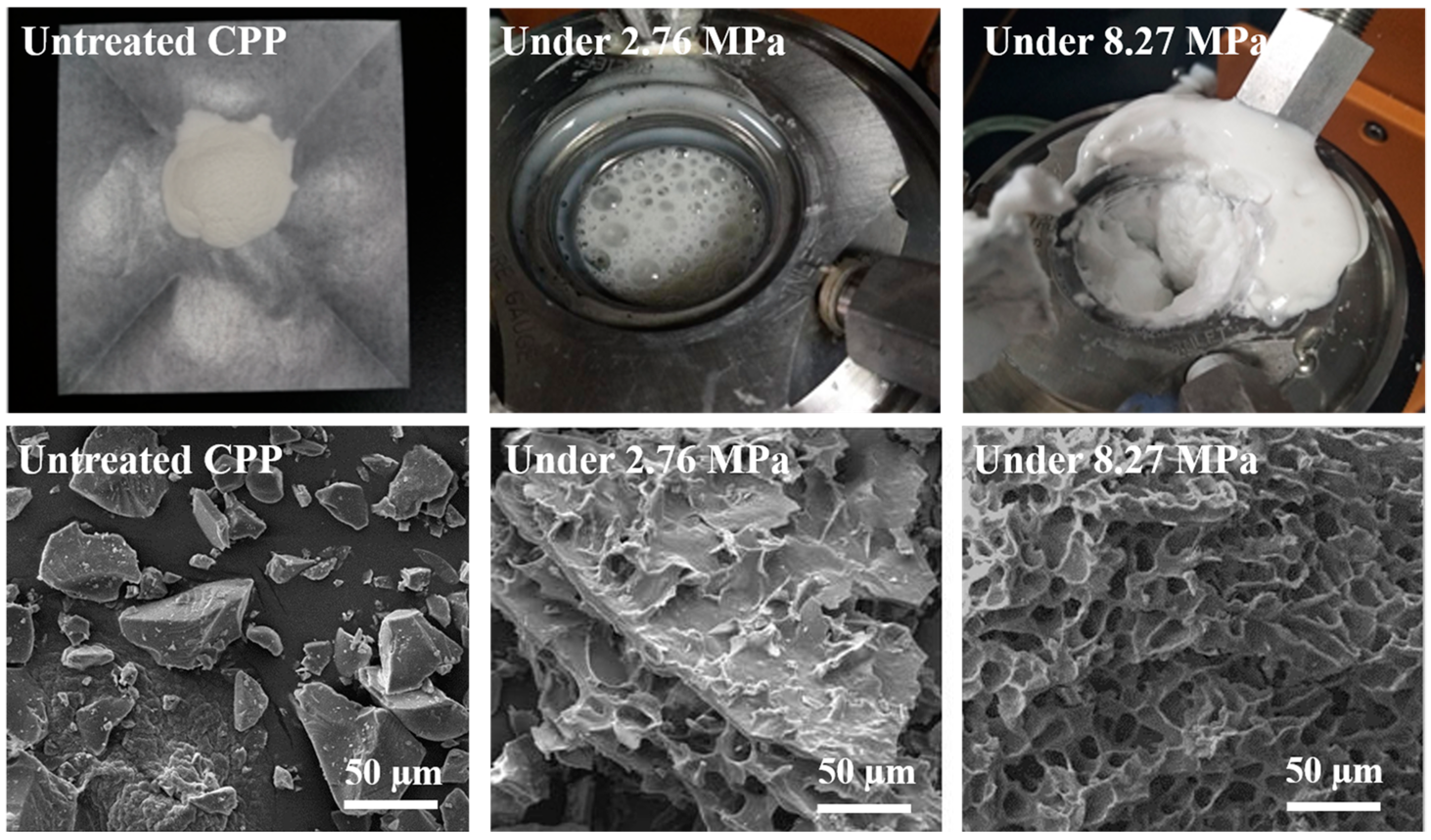
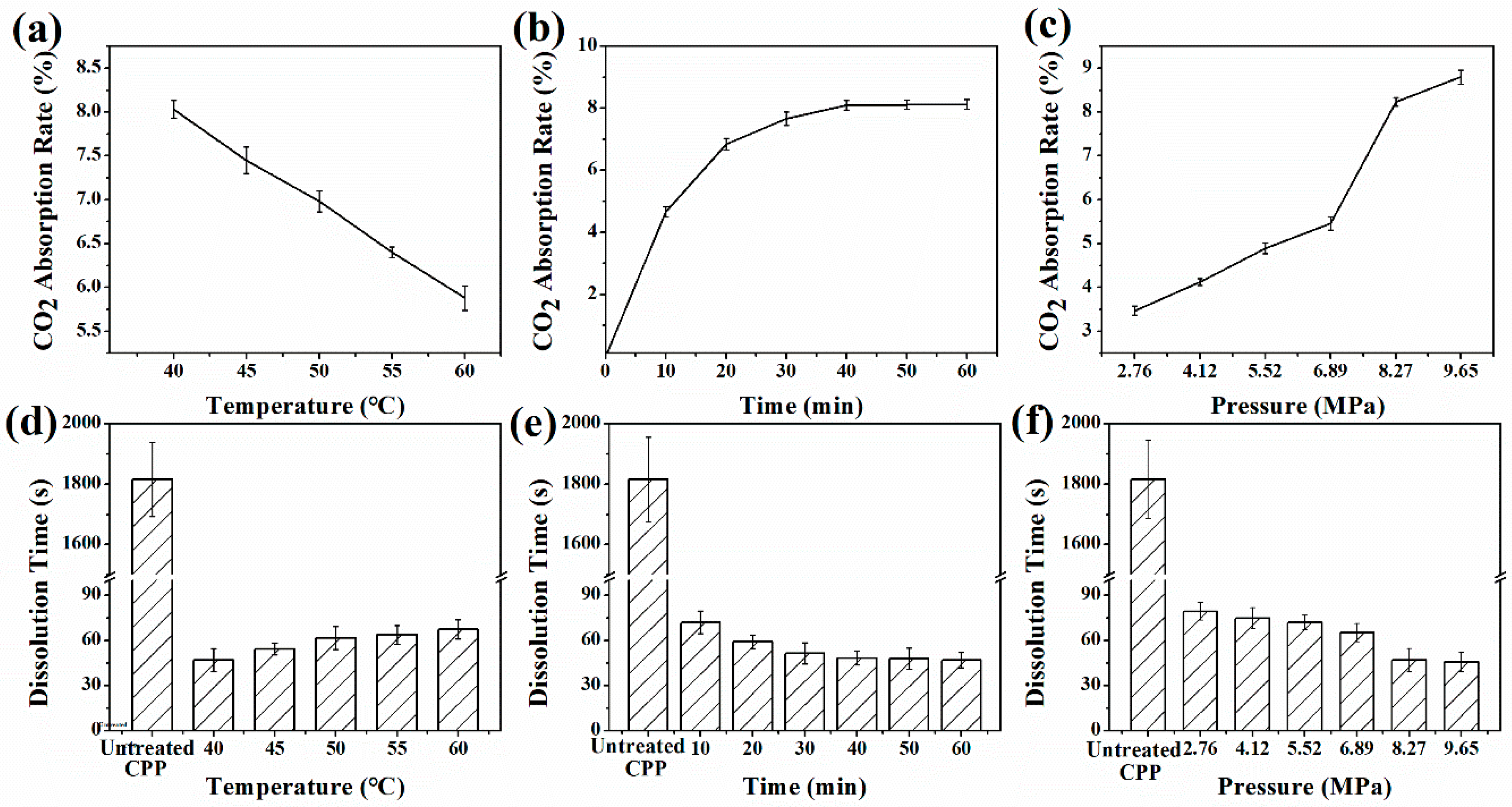
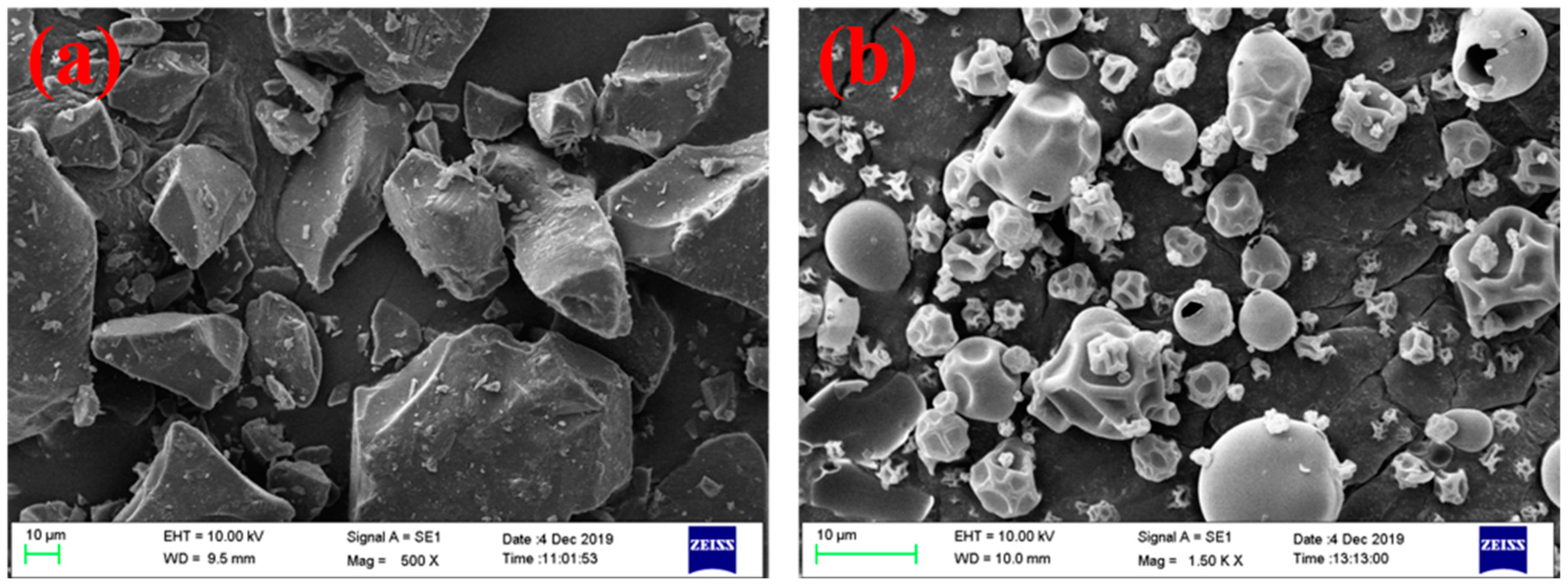
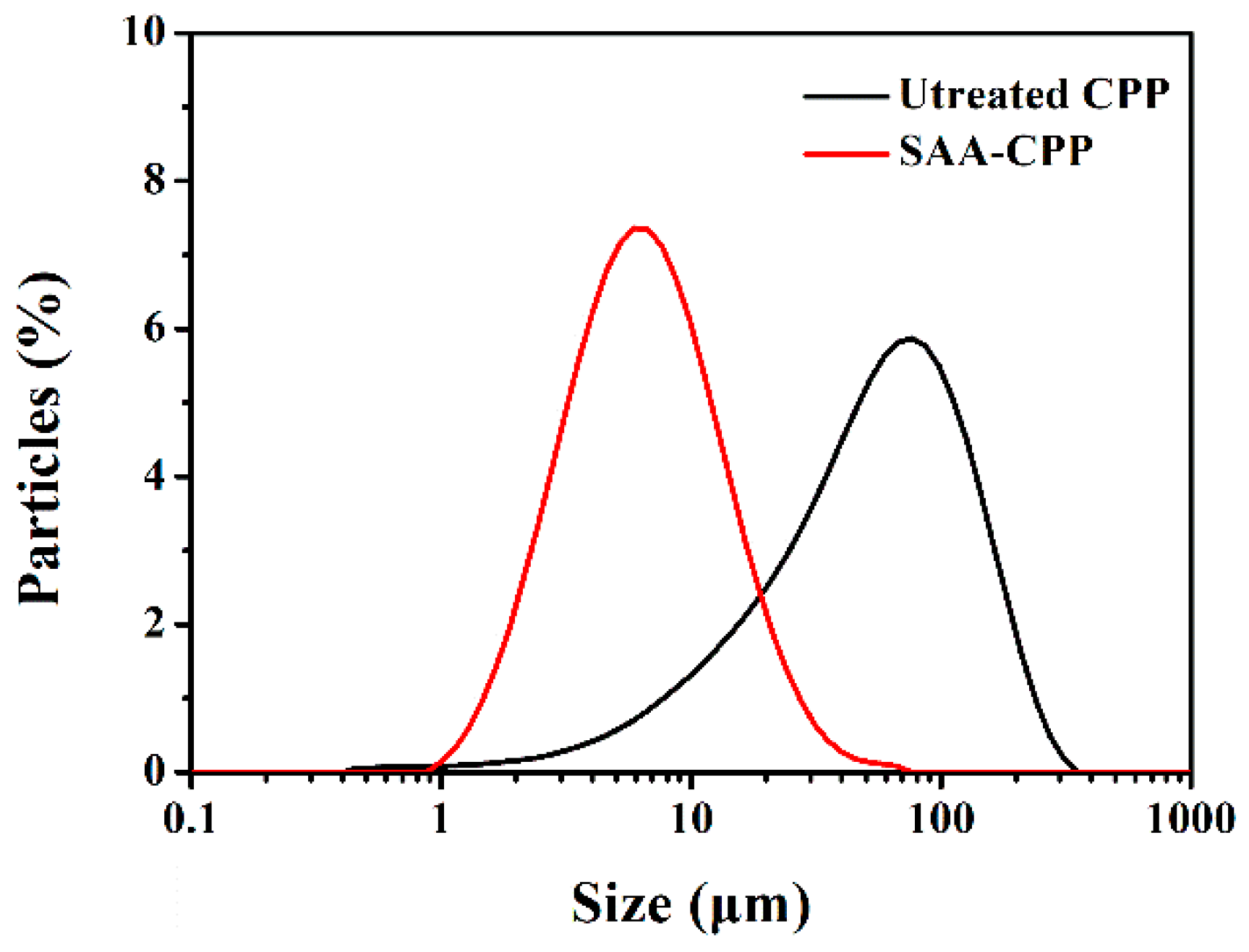
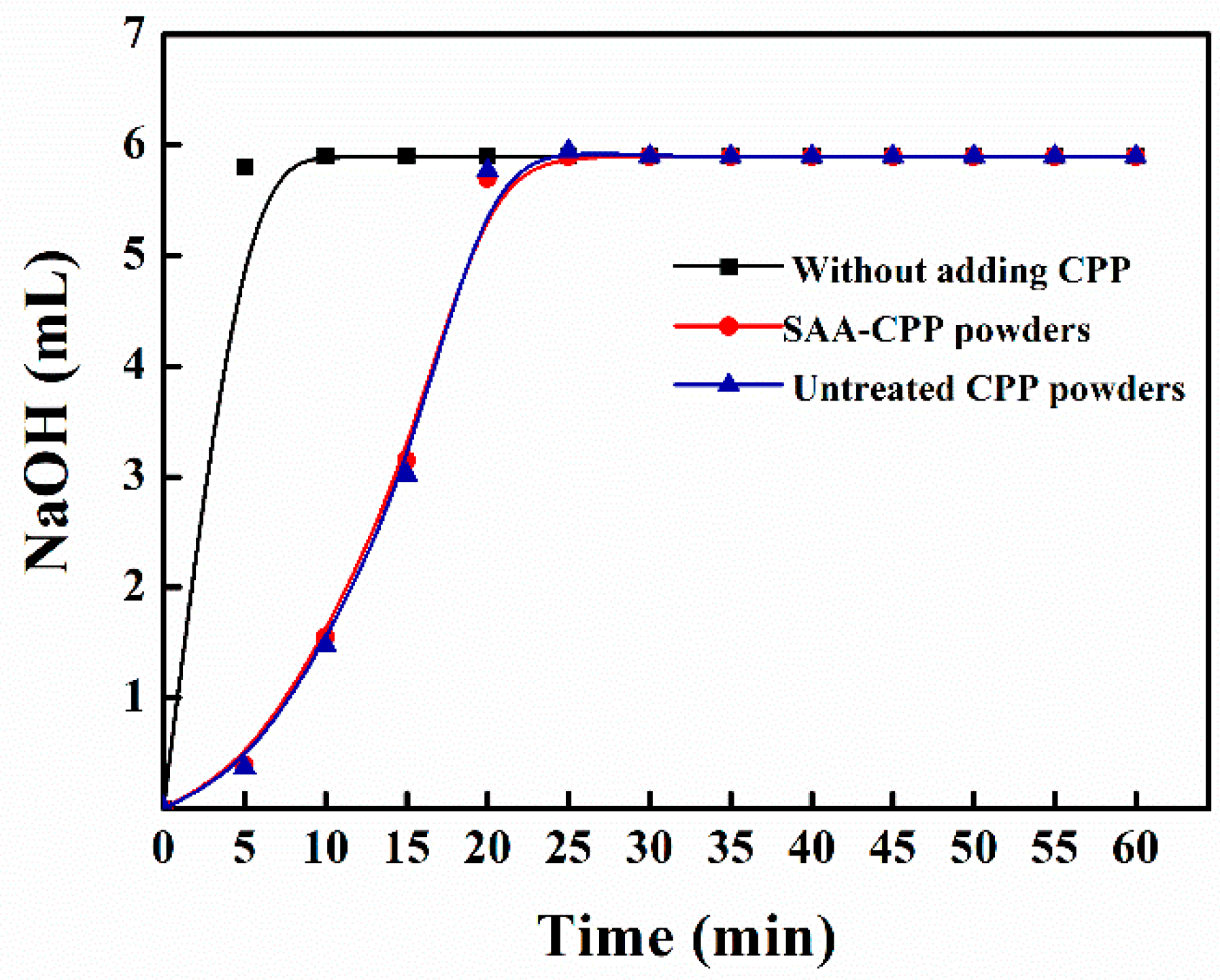

| Sample Codes | Temperature (°C) | Time (min) | Pressure (MPa) |
|---|---|---|---|
| Untreated CPP | - | - | - |
| Effect of temperature, Tm | |||
| 1 | 40 | 40 | 8.27 |
| 2 | 45 | 40 | 8.27 |
| 3 | 50 | 40 | 8.27 |
| 4 | 55 | 40 | 8.27 |
| 5 | 60 | 40 | 8.27 |
| Effect of time, Tt | |||
| 6 | 40 | 10 | 8.27 |
| 7 | 40 | 20 | 8.27 |
| 8 | 40 | 30 | 8.27 |
| 9 | 40 | 40 | 8.27 |
| 10 | 40 | 50 | 8.27 |
| 11 | 40 | 60 | 8.27 |
| Effect of pressure, P | |||
| 12 | 40 | 40 | 2.76 |
| 13 | 40 | 40 | 4.12 |
| 14 | 40 | 40 | 5.52 |
| 15 | 40 | 40 | 6.89 |
| 16 | 40 | 40 | 8.27 |
| 17 | 40 | 40 | 9.65 |
| Samples | Specific Surface Area (m2/g) | Total Volume in Pores (cm3/g) | Total Area in Pores (m2/g) |
|---|---|---|---|
| Untreated CPP | 0.263 ± 0.006 b | 0.00028 ± 0.00002 b | 0.098 ± 0.003 b |
| SAA-CPP | 2.40 ± 0.12 a | 0.00157 ± 0.00008 a | 0.963 ± 0.012 a |
| Samples | Hydroxyl Radical Scavenging Ability (U/mL) | Total Antioxidant Capacity (U/mL) | Foam Ability (%) | Foam Stability (%) | Conductivity (μS/cm) |
|---|---|---|---|---|---|
| Untreated CPP | 97.5 ± 0.6 a | 2.22 ± 0.08 a | 60.2 ± 0.3 a | 53.3 ± 0.8 a | 1043 ± 2 a |
| SAA-CPP | 97.3 ± 0.8 a | 2.15 ± 0.09 a | 56.1 ± 0.3 b | 1.32 ± 0.14 b | 1039 ± 1 b |
Publisher’s Note: MDPI stays neutral with regard to jurisdictional claims in published maps and institutional affiliations. |
© 2021 by the authors. Licensee MDPI, Basel, Switzerland. This article is an open access article distributed under the terms and conditions of the Creative Commons Attribution (CC BY) license (https://creativecommons.org/licenses/by/4.0/).
Share and Cite
Zhu, J.; Liu, H.; Cai, X.; Wu, W.; Zhu, Z.; Yu, L. Preparation and Characterization of Instant Casein Phosphopeptide by Supercritical Fluid Assisted Atomization. Foods 2021, 10, 1555. https://doi.org/10.3390/foods10071555
Zhu J, Liu H, Cai X, Wu W, Zhu Z, Yu L. Preparation and Characterization of Instant Casein Phosphopeptide by Supercritical Fluid Assisted Atomization. Foods. 2021; 10(7):1555. https://doi.org/10.3390/foods10071555
Chicago/Turabian StyleZhu, Jian, Hongsheng Liu, Xingzhe Cai, Wei Wu, Zhiyi Zhu, and Long Yu. 2021. "Preparation and Characterization of Instant Casein Phosphopeptide by Supercritical Fluid Assisted Atomization" Foods 10, no. 7: 1555. https://doi.org/10.3390/foods10071555
APA StyleZhu, J., Liu, H., Cai, X., Wu, W., Zhu, Z., & Yu, L. (2021). Preparation and Characterization of Instant Casein Phosphopeptide by Supercritical Fluid Assisted Atomization. Foods, 10(7), 1555. https://doi.org/10.3390/foods10071555






